Analyzing Consumer Animosity: Marketing Strategies in Australia
VerifiedAdded on 2023/06/03
|11
|2641
|369
Case Study
AI Summary
This case study examines consumer animosity, focusing on the Australian context, particularly in relation to France's nuclear testing in the South Pacific. It explores the concept of consumer animosity, differentiating between situational and stable animosity, and discusses factors that influence consumer behavior, such as ethnocentrism and product quality perceptions. The study also investigates strategies marketers can use to mitigate the negative impacts of consumer animosity, including enhancing brand quality, building consumer trust through communication and CSR activities, and forming strong local partnerships. The conclusion emphasizes the importance of understanding various factors influencing consumer buying decisions and suggests further research into consumer behavior in the face of international issues.
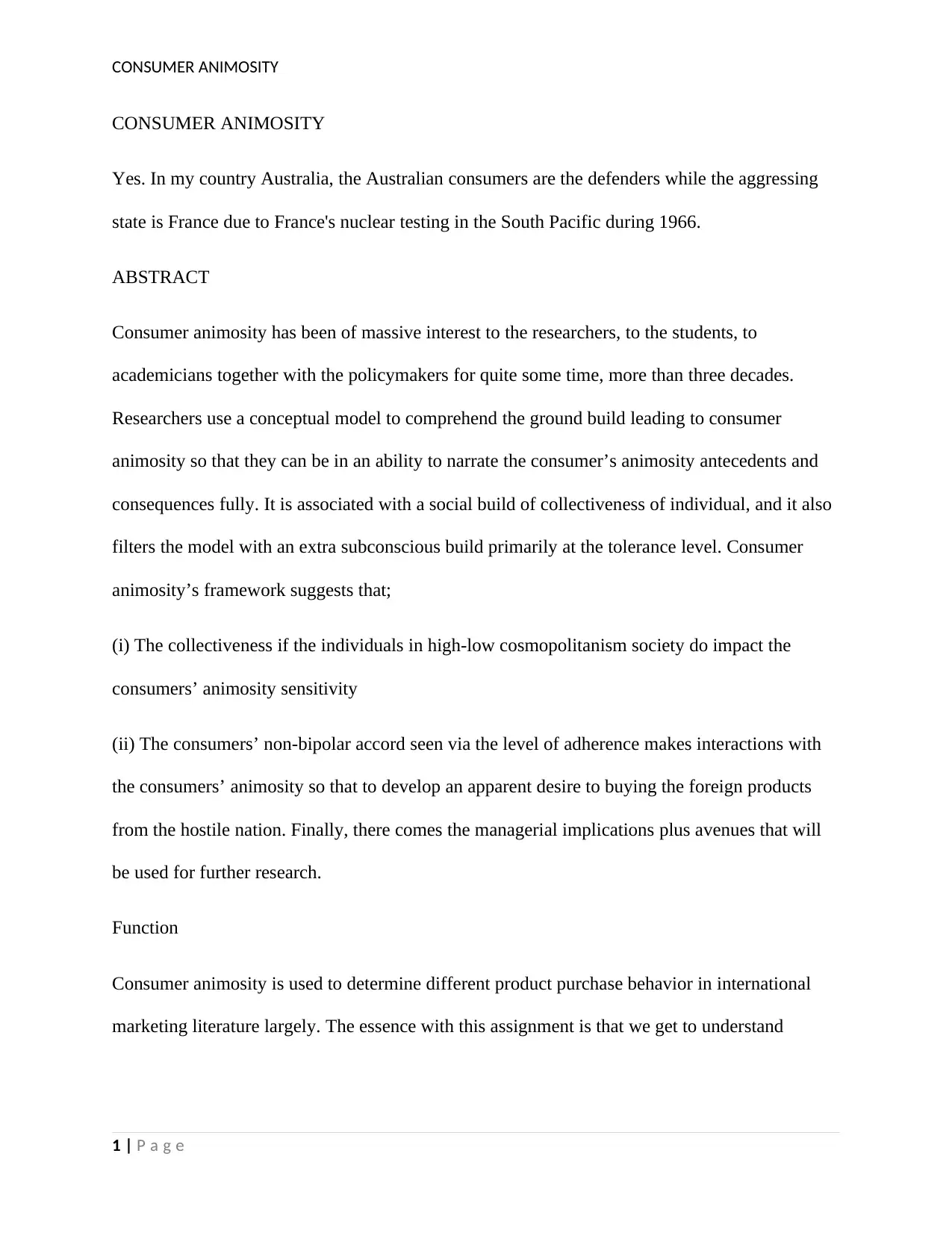
CONSUMER ANIMOSITY
CONSUMER ANIMOSITY
Yes. In my country Australia, the Australian consumers are the defenders while the aggressing
state is France due to France's nuclear testing in the South Pacific during 1966.
ABSTRACT
Consumer animosity has been of massive interest to the researchers, to the students, to
academicians together with the policymakers for quite some time, more than three decades.
Researchers use a conceptual model to comprehend the ground build leading to consumer
animosity so that they can be in an ability to narrate the consumer’s animosity antecedents and
consequences fully. It is associated with a social build of collectiveness of individual, and it also
filters the model with an extra subconscious build primarily at the tolerance level. Consumer
animosity’s framework suggests that;
(i) The collectiveness if the individuals in high-low cosmopolitanism society do impact the
consumers’ animosity sensitivity
(ii) The consumers’ non-bipolar accord seen via the level of adherence makes interactions with
the consumers’ animosity so that to develop an apparent desire to buying the foreign products
from the hostile nation. Finally, there comes the managerial implications plus avenues that will
be used for further research.
Function
Consumer animosity is used to determine different product purchase behavior in international
marketing literature largely. The essence with this assignment is that we get to understand
1 | P a g e
CONSUMER ANIMOSITY
Yes. In my country Australia, the Australian consumers are the defenders while the aggressing
state is France due to France's nuclear testing in the South Pacific during 1966.
ABSTRACT
Consumer animosity has been of massive interest to the researchers, to the students, to
academicians together with the policymakers for quite some time, more than three decades.
Researchers use a conceptual model to comprehend the ground build leading to consumer
animosity so that they can be in an ability to narrate the consumer’s animosity antecedents and
consequences fully. It is associated with a social build of collectiveness of individual, and it also
filters the model with an extra subconscious build primarily at the tolerance level. Consumer
animosity’s framework suggests that;
(i) The collectiveness if the individuals in high-low cosmopolitanism society do impact the
consumers’ animosity sensitivity
(ii) The consumers’ non-bipolar accord seen via the level of adherence makes interactions with
the consumers’ animosity so that to develop an apparent desire to buying the foreign products
from the hostile nation. Finally, there comes the managerial implications plus avenues that will
be used for further research.
Function
Consumer animosity is used to determine different product purchase behavior in international
marketing literature largely. The essence with this assignment is that we get to understand
1 | P a g e
Paraphrase This Document
Need a fresh take? Get an instant paraphrase of this document with our AI Paraphraser
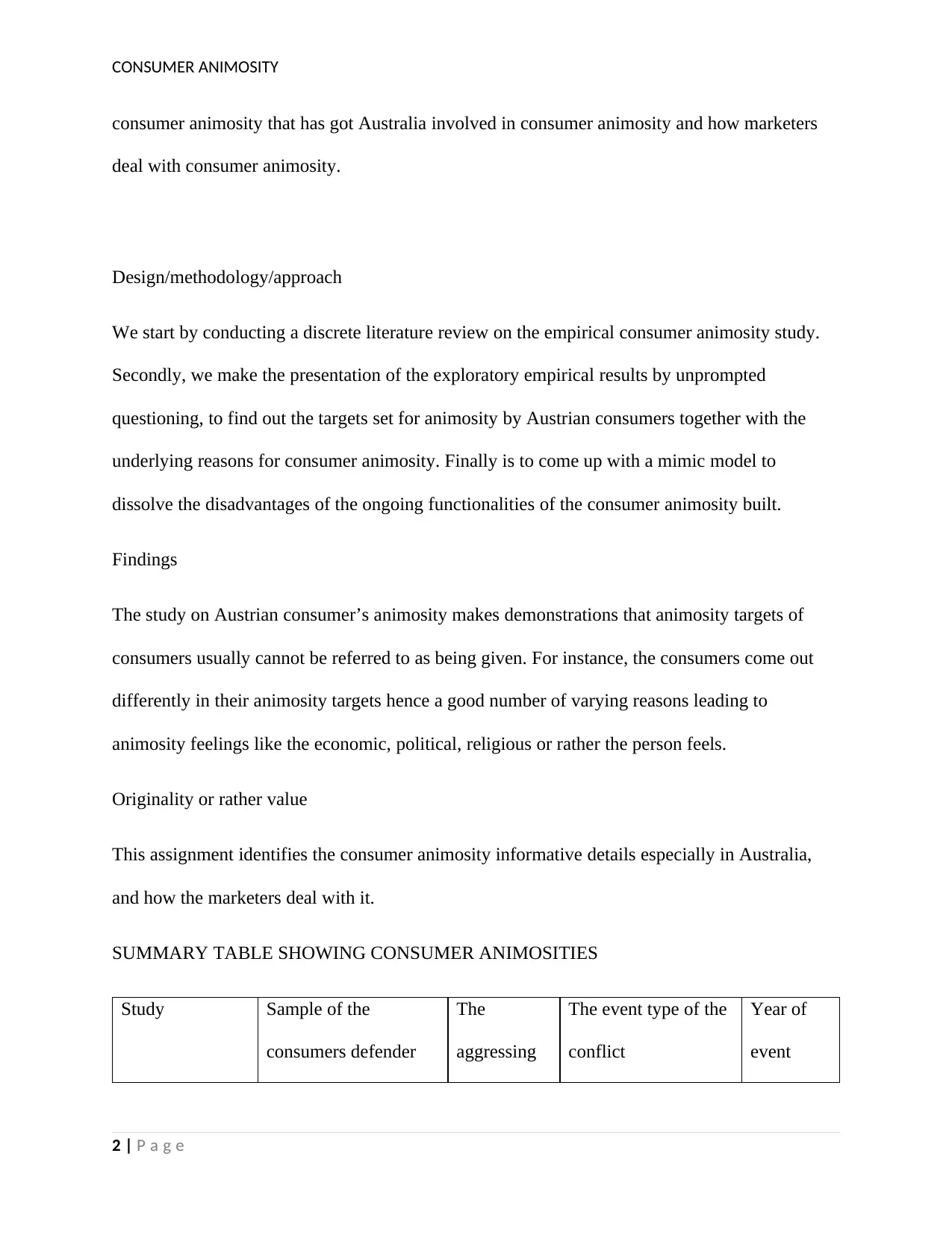
CONSUMER ANIMOSITY
consumer animosity that has got Australia involved in consumer animosity and how marketers
deal with consumer animosity.
Design/methodology/approach
We start by conducting a discrete literature review on the empirical consumer animosity study.
Secondly, we make the presentation of the exploratory empirical results by unprompted
questioning, to find out the targets set for animosity by Austrian consumers together with the
underlying reasons for consumer animosity. Finally is to come up with a mimic model to
dissolve the disadvantages of the ongoing functionalities of the consumer animosity built.
Findings
The study on Austrian consumer’s animosity makes demonstrations that animosity targets of
consumers usually cannot be referred to as being given. For instance, the consumers come out
differently in their animosity targets hence a good number of varying reasons leading to
animosity feelings like the economic, political, religious or rather the person feels.
Originality or rather value
This assignment identifies the consumer animosity informative details especially in Australia,
and how the marketers deal with it.
SUMMARY TABLE SHOWING CONSUMER ANIMOSITIES
Study Sample of the
consumers defender
The
aggressing
The event type of the
conflict
Year of
event
2 | P a g e
consumer animosity that has got Australia involved in consumer animosity and how marketers
deal with consumer animosity.
Design/methodology/approach
We start by conducting a discrete literature review on the empirical consumer animosity study.
Secondly, we make the presentation of the exploratory empirical results by unprompted
questioning, to find out the targets set for animosity by Austrian consumers together with the
underlying reasons for consumer animosity. Finally is to come up with a mimic model to
dissolve the disadvantages of the ongoing functionalities of the consumer animosity built.
Findings
The study on Austrian consumer’s animosity makes demonstrations that animosity targets of
consumers usually cannot be referred to as being given. For instance, the consumers come out
differently in their animosity targets hence a good number of varying reasons leading to
animosity feelings like the economic, political, religious or rather the person feels.
Originality or rather value
This assignment identifies the consumer animosity informative details especially in Australia,
and how the marketers deal with it.
SUMMARY TABLE SHOWING CONSUMER ANIMOSITIES
Study Sample of the
consumers defender
The
aggressing
The event type of the
conflict
Year of
event
2 | P a g e
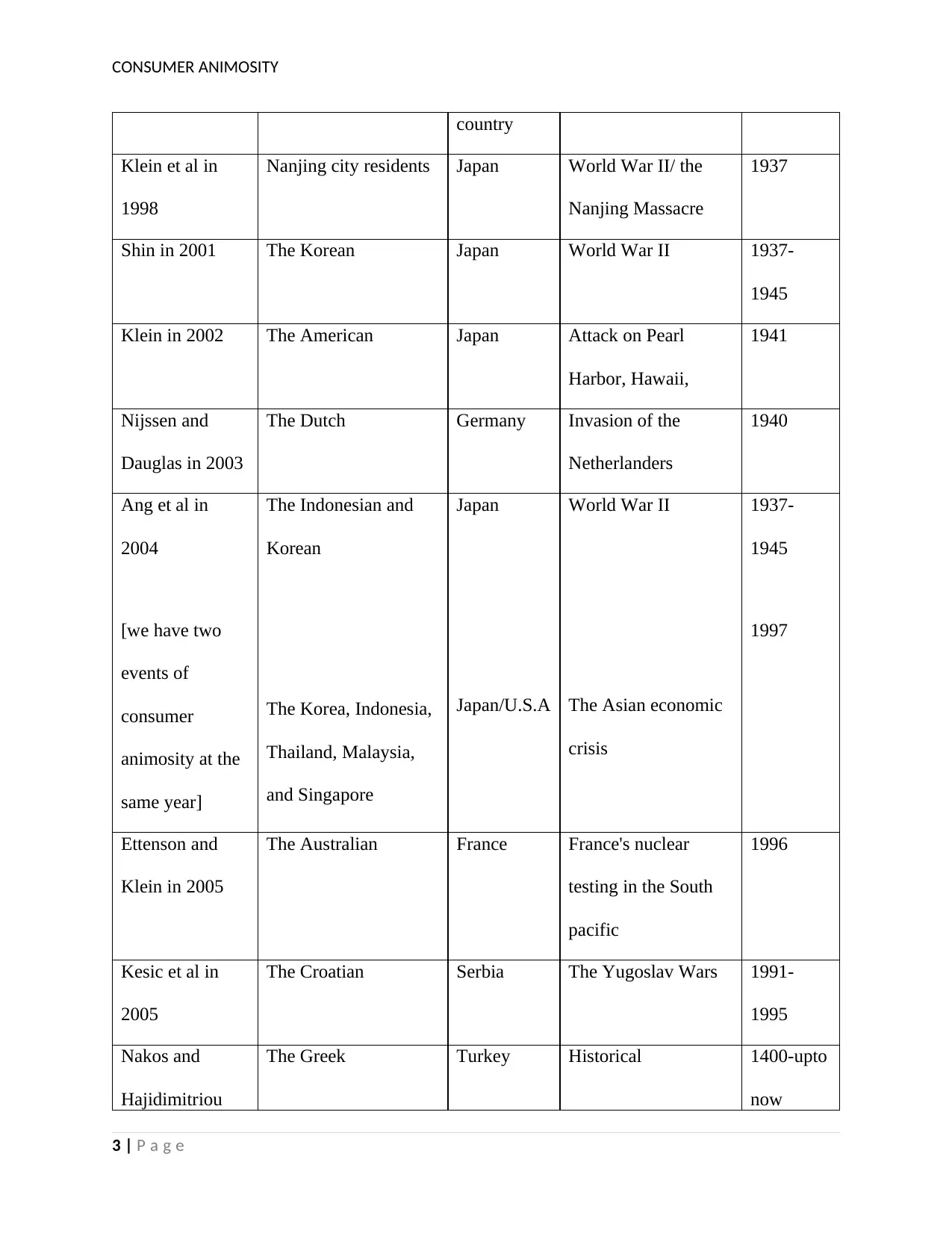
CONSUMER ANIMOSITY
country
Klein et al in
1998
Nanjing city residents Japan World War II/ the
Nanjing Massacre
1937
Shin in 2001 The Korean Japan World War II 1937-
1945
Klein in 2002 The American Japan Attack on Pearl
Harbor, Hawaii,
1941
Nijssen and
Dauglas in 2003
The Dutch Germany Invasion of the
Netherlanders
1940
Ang et al in
2004
[we have two
events of
consumer
animosity at the
same year]
The Indonesian and
Korean
The Korea, Indonesia,
Thailand, Malaysia,
and Singapore
Japan
Japan/U.S.A
World War II
The Asian economic
crisis
1937-
1945
1997
Ettenson and
Klein in 2005
The Australian France France's nuclear
testing in the South
pacific
1996
Kesic et al in
2005
The Croatian Serbia The Yugoslav Wars 1991-
1995
Nakos and
Hajidimitriou
The Greek Turkey Historical 1400-upto
now
3 | P a g e
country
Klein et al in
1998
Nanjing city residents Japan World War II/ the
Nanjing Massacre
1937
Shin in 2001 The Korean Japan World War II 1937-
1945
Klein in 2002 The American Japan Attack on Pearl
Harbor, Hawaii,
1941
Nijssen and
Dauglas in 2003
The Dutch Germany Invasion of the
Netherlanders
1940
Ang et al in
2004
[we have two
events of
consumer
animosity at the
same year]
The Indonesian and
Korean
The Korea, Indonesia,
Thailand, Malaysia,
and Singapore
Japan
Japan/U.S.A
World War II
The Asian economic
crisis
1937-
1945
1997
Ettenson and
Klein in 2005
The Australian France France's nuclear
testing in the South
pacific
1996
Kesic et al in
2005
The Croatian Serbia The Yugoslav Wars 1991-
1995
Nakos and
Hajidimitriou
The Greek Turkey Historical 1400-upto
now
3 | P a g e
⊘ This is a preview!⊘
Do you want full access?
Subscribe today to unlock all pages.

Trusted by 1+ million students worldwide
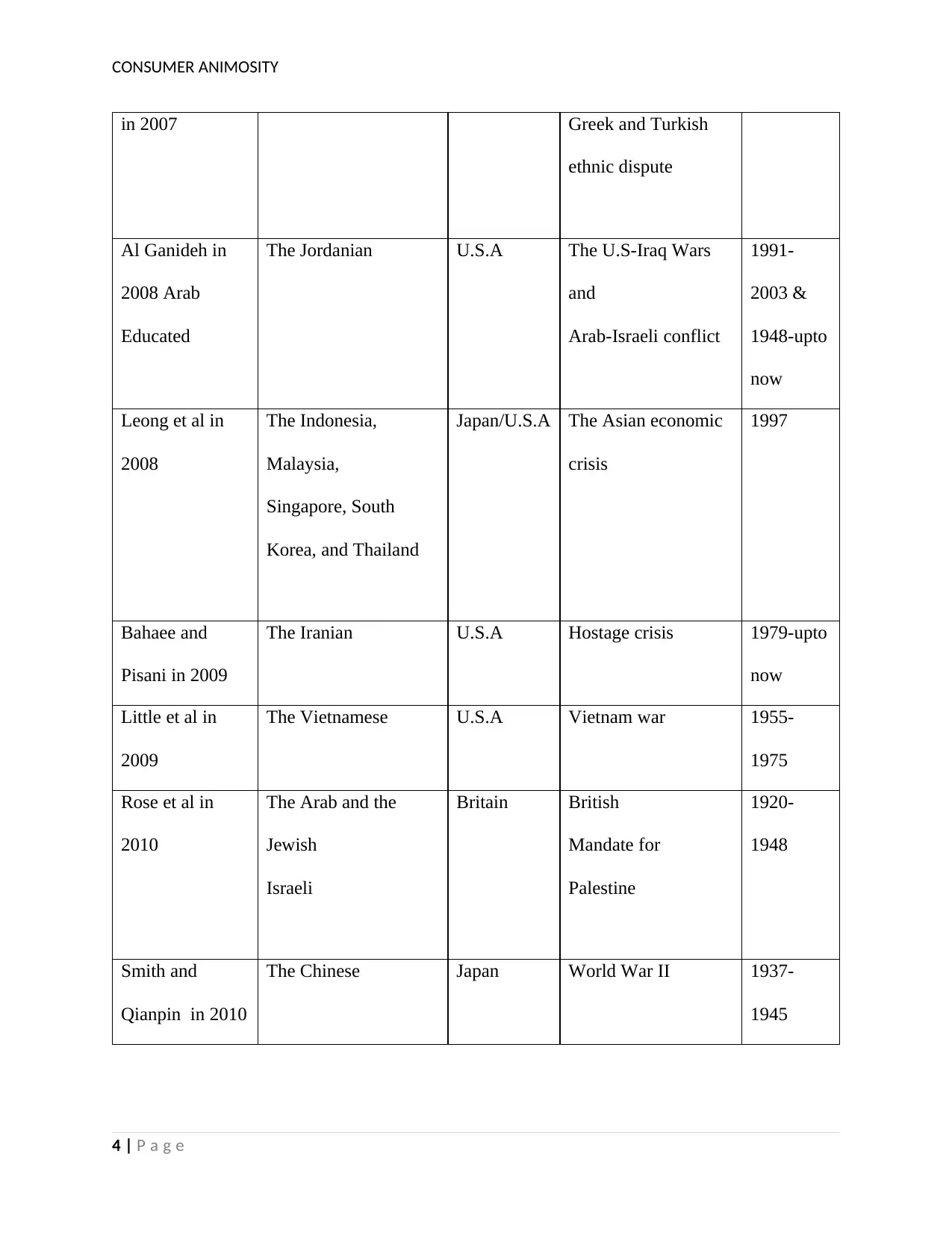
CONSUMER ANIMOSITY
in 2007 Greek and Turkish
ethnic dispute
Al Ganideh in
2008 Arab
Educated
The Jordanian U.S.A The U.S-Iraq Wars
and
Arab-Israeli conflict
1991-
2003 &
1948-upto
now
Leong et al in
2008
The Indonesia,
Malaysia,
Singapore, South
Korea, and Thailand
Japan/U.S.A The Asian economic
crisis
1997
Bahaee and
Pisani in 2009
The Iranian U.S.A Hostage crisis 1979-upto
now
Little et al in
2009
The Vietnamese U.S.A Vietnam war 1955-
1975
Rose et al in
2010
The Arab and the
Jewish
Israeli
Britain British
Mandate for
Palestine
1920-
1948
Smith and
Qianpin in 2010
The Chinese Japan World War II 1937-
1945
4 | P a g e
in 2007 Greek and Turkish
ethnic dispute
Al Ganideh in
2008 Arab
Educated
The Jordanian U.S.A The U.S-Iraq Wars
and
Arab-Israeli conflict
1991-
2003 &
1948-upto
now
Leong et al in
2008
The Indonesia,
Malaysia,
Singapore, South
Korea, and Thailand
Japan/U.S.A The Asian economic
crisis
1997
Bahaee and
Pisani in 2009
The Iranian U.S.A Hostage crisis 1979-upto
now
Little et al in
2009
The Vietnamese U.S.A Vietnam war 1955-
1975
Rose et al in
2010
The Arab and the
Jewish
Israeli
Britain British
Mandate for
Palestine
1920-
1948
Smith and
Qianpin in 2010
The Chinese Japan World War II 1937-
1945
4 | P a g e
Paraphrase This Document
Need a fresh take? Get an instant paraphrase of this document with our AI Paraphraser
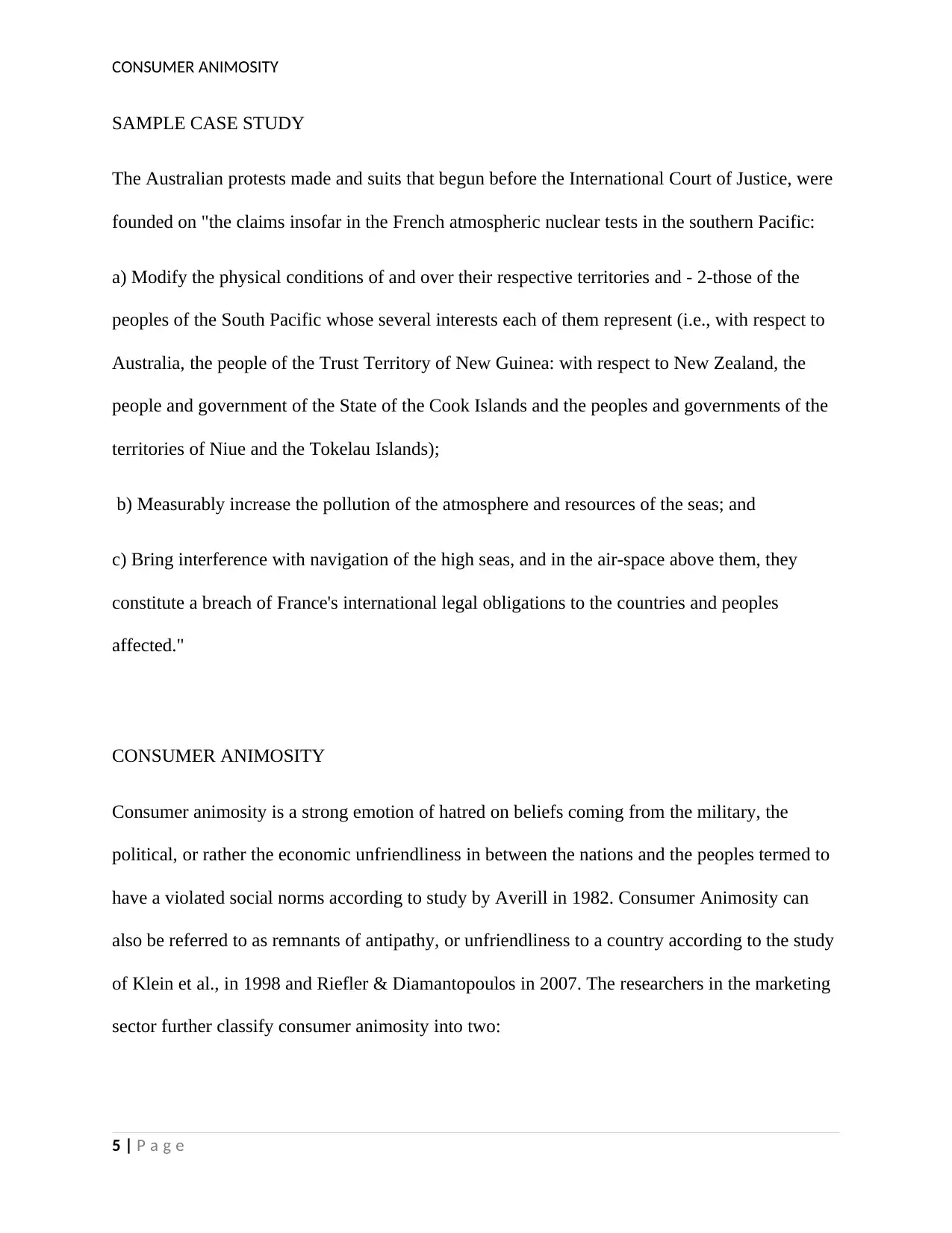
CONSUMER ANIMOSITY
SAMPLE CASE STUDY
The Australian protests made and suits that begun before the International Court of Justice, were
founded on "the claims insofar in the French atmospheric nuclear tests in the southern Pacific:
a) Modify the physical conditions of and over their respective territories and - 2-those of the
peoples of the South Pacific whose several interests each of them represent (i.e., with respect to
Australia, the people of the Trust Territory of New Guinea: with respect to New Zealand, the
people and government of the State of the Cook Islands and the peoples and governments of the
territories of Niue and the Tokelau Islands);
b) Measurably increase the pollution of the atmosphere and resources of the seas; and
c) Bring interference with navigation of the high seas, and in the air-space above them, they
constitute a breach of France's international legal obligations to the countries and peoples
affected."
CONSUMER ANIMOSITY
Consumer animosity is a strong emotion of hatred on beliefs coming from the military, the
political, or rather the economic unfriendliness in between the nations and the peoples termed to
have a violated social norms according to study by Averill in 1982. Consumer Animosity can
also be referred to as remnants of antipathy, or unfriendliness to a country according to the study
of Klein et al., in 1998 and Riefler & Diamantopoulos in 2007. The researchers in the marketing
sector further classify consumer animosity into two:
5 | P a g e
SAMPLE CASE STUDY
The Australian protests made and suits that begun before the International Court of Justice, were
founded on "the claims insofar in the French atmospheric nuclear tests in the southern Pacific:
a) Modify the physical conditions of and over their respective territories and - 2-those of the
peoples of the South Pacific whose several interests each of them represent (i.e., with respect to
Australia, the people of the Trust Territory of New Guinea: with respect to New Zealand, the
people and government of the State of the Cook Islands and the peoples and governments of the
territories of Niue and the Tokelau Islands);
b) Measurably increase the pollution of the atmosphere and resources of the seas; and
c) Bring interference with navigation of the high seas, and in the air-space above them, they
constitute a breach of France's international legal obligations to the countries and peoples
affected."
CONSUMER ANIMOSITY
Consumer animosity is a strong emotion of hatred on beliefs coming from the military, the
political, or rather the economic unfriendliness in between the nations and the peoples termed to
have a violated social norms according to study by Averill in 1982. Consumer Animosity can
also be referred to as remnants of antipathy, or unfriendliness to a country according to the study
of Klein et al., in 1998 and Riefler & Diamantopoulos in 2007. The researchers in the marketing
sector further classify consumer animosity into two:
5 | P a g e
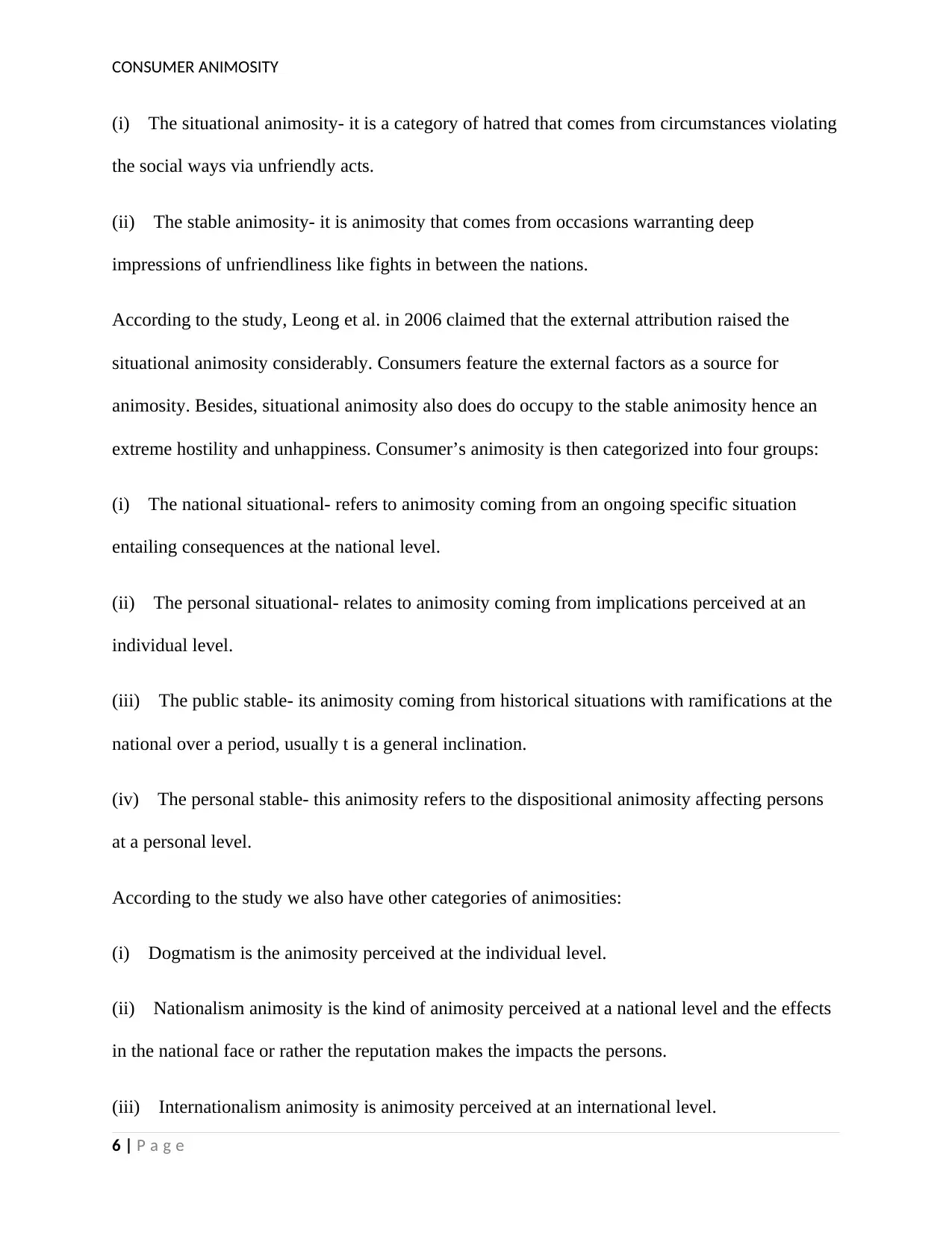
CONSUMER ANIMOSITY
(i) The situational animosity- it is a category of hatred that comes from circumstances violating
the social ways via unfriendly acts.
(ii) The stable animosity- it is animosity that comes from occasions warranting deep
impressions of unfriendliness like fights in between the nations.
According to the study, Leong et al. in 2006 claimed that the external attribution raised the
situational animosity considerably. Consumers feature the external factors as a source for
animosity. Besides, situational animosity also does do occupy to the stable animosity hence an
extreme hostility and unhappiness. Consumer’s animosity is then categorized into four groups:
(i) The national situational- refers to animosity coming from an ongoing specific situation
entailing consequences at the national level.
(ii) The personal situational- relates to animosity coming from implications perceived at an
individual level.
(iii) The public stable- its animosity coming from historical situations with ramifications at the
national over a period, usually t is a general inclination.
(iv) The personal stable- this animosity refers to the dispositional animosity affecting persons
at a personal level.
According to the study we also have other categories of animosities:
(i) Dogmatism is the animosity perceived at the individual level.
(ii) Nationalism animosity is the kind of animosity perceived at a national level and the effects
in the national face or rather the reputation makes the impacts the persons.
(iii) Internationalism animosity is animosity perceived at an international level.
6 | P a g e
(i) The situational animosity- it is a category of hatred that comes from circumstances violating
the social ways via unfriendly acts.
(ii) The stable animosity- it is animosity that comes from occasions warranting deep
impressions of unfriendliness like fights in between the nations.
According to the study, Leong et al. in 2006 claimed that the external attribution raised the
situational animosity considerably. Consumers feature the external factors as a source for
animosity. Besides, situational animosity also does do occupy to the stable animosity hence an
extreme hostility and unhappiness. Consumer’s animosity is then categorized into four groups:
(i) The national situational- refers to animosity coming from an ongoing specific situation
entailing consequences at the national level.
(ii) The personal situational- relates to animosity coming from implications perceived at an
individual level.
(iii) The public stable- its animosity coming from historical situations with ramifications at the
national over a period, usually t is a general inclination.
(iv) The personal stable- this animosity refers to the dispositional animosity affecting persons
at a personal level.
According to the study we also have other categories of animosities:
(i) Dogmatism is the animosity perceived at the individual level.
(ii) Nationalism animosity is the kind of animosity perceived at a national level and the effects
in the national face or rather the reputation makes the impacts the persons.
(iii) Internationalism animosity is animosity perceived at an international level.
6 | P a g e
⊘ This is a preview!⊘
Do you want full access?
Subscribe today to unlock all pages.

Trusted by 1+ million students worldwide
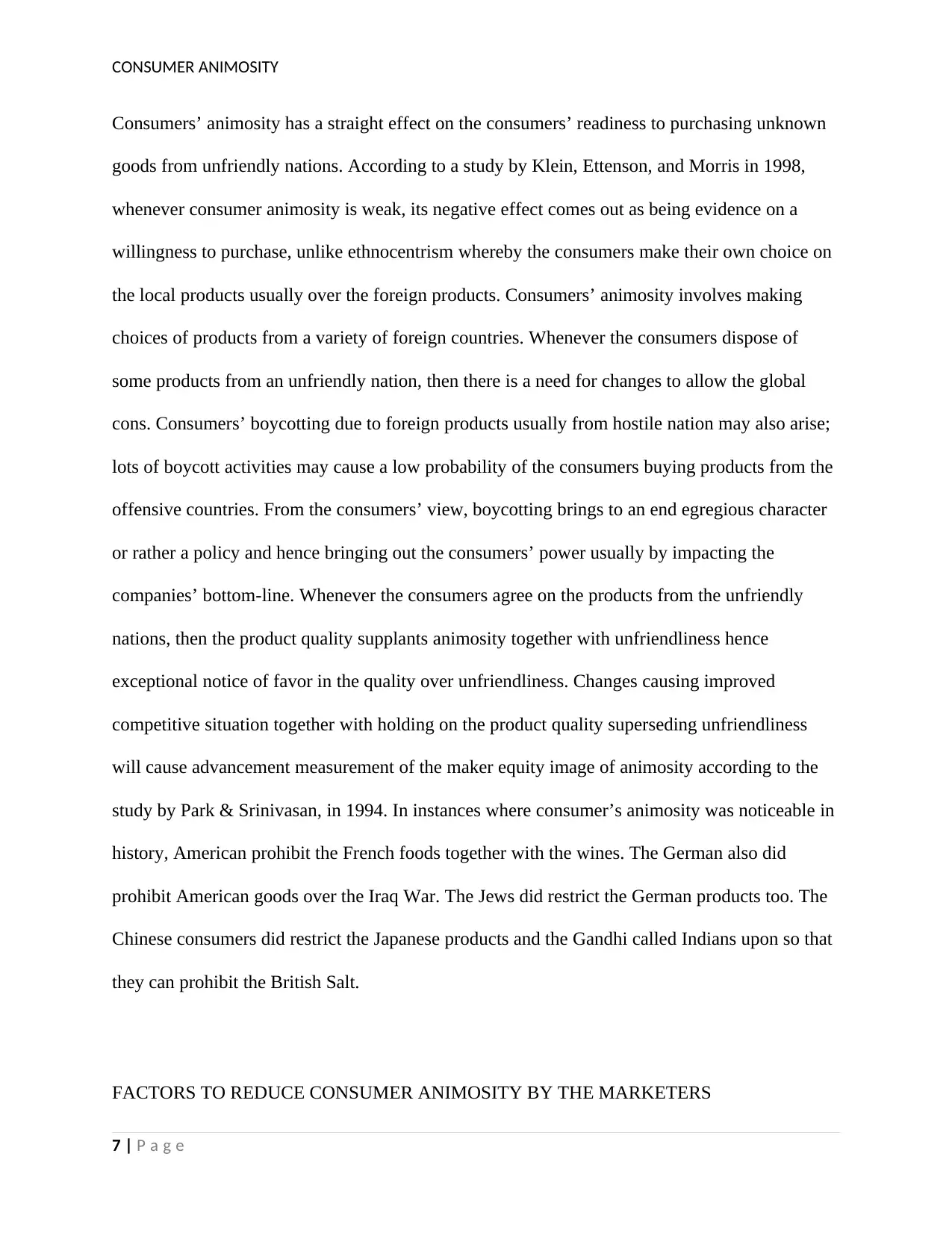
CONSUMER ANIMOSITY
Consumers’ animosity has a straight effect on the consumers’ readiness to purchasing unknown
goods from unfriendly nations. According to a study by Klein, Ettenson, and Morris in 1998,
whenever consumer animosity is weak, its negative effect comes out as being evidence on a
willingness to purchase, unlike ethnocentrism whereby the consumers make their own choice on
the local products usually over the foreign products. Consumers’ animosity involves making
choices of products from a variety of foreign countries. Whenever the consumers dispose of
some products from an unfriendly nation, then there is a need for changes to allow the global
cons. Consumers’ boycotting due to foreign products usually from hostile nation may also arise;
lots of boycott activities may cause a low probability of the consumers buying products from the
offensive countries. From the consumers’ view, boycotting brings to an end egregious character
or rather a policy and hence bringing out the consumers’ power usually by impacting the
companies’ bottom-line. Whenever the consumers agree on the products from the unfriendly
nations, then the product quality supplants animosity together with unfriendliness hence
exceptional notice of favor in the quality over unfriendliness. Changes causing improved
competitive situation together with holding on the product quality superseding unfriendliness
will cause advancement measurement of the maker equity image of animosity according to the
study by Park & Srinivasan, in 1994. In instances where consumer’s animosity was noticeable in
history, American prohibit the French foods together with the wines. The German also did
prohibit American goods over the Iraq War. The Jews did restrict the German products too. The
Chinese consumers did restrict the Japanese products and the Gandhi called Indians upon so that
they can prohibit the British Salt.
FACTORS TO REDUCE CONSUMER ANIMOSITY BY THE MARKETERS
7 | P a g e
Consumers’ animosity has a straight effect on the consumers’ readiness to purchasing unknown
goods from unfriendly nations. According to a study by Klein, Ettenson, and Morris in 1998,
whenever consumer animosity is weak, its negative effect comes out as being evidence on a
willingness to purchase, unlike ethnocentrism whereby the consumers make their own choice on
the local products usually over the foreign products. Consumers’ animosity involves making
choices of products from a variety of foreign countries. Whenever the consumers dispose of
some products from an unfriendly nation, then there is a need for changes to allow the global
cons. Consumers’ boycotting due to foreign products usually from hostile nation may also arise;
lots of boycott activities may cause a low probability of the consumers buying products from the
offensive countries. From the consumers’ view, boycotting brings to an end egregious character
or rather a policy and hence bringing out the consumers’ power usually by impacting the
companies’ bottom-line. Whenever the consumers agree on the products from the unfriendly
nations, then the product quality supplants animosity together with unfriendliness hence
exceptional notice of favor in the quality over unfriendliness. Changes causing improved
competitive situation together with holding on the product quality superseding unfriendliness
will cause advancement measurement of the maker equity image of animosity according to the
study by Park & Srinivasan, in 1994. In instances where consumer’s animosity was noticeable in
history, American prohibit the French foods together with the wines. The German also did
prohibit American goods over the Iraq War. The Jews did restrict the German products too. The
Chinese consumers did restrict the Japanese products and the Gandhi called Indians upon so that
they can prohibit the British Salt.
FACTORS TO REDUCE CONSUMER ANIMOSITY BY THE MARKETERS
7 | P a g e
Paraphrase This Document
Need a fresh take? Get an instant paraphrase of this document with our AI Paraphraser
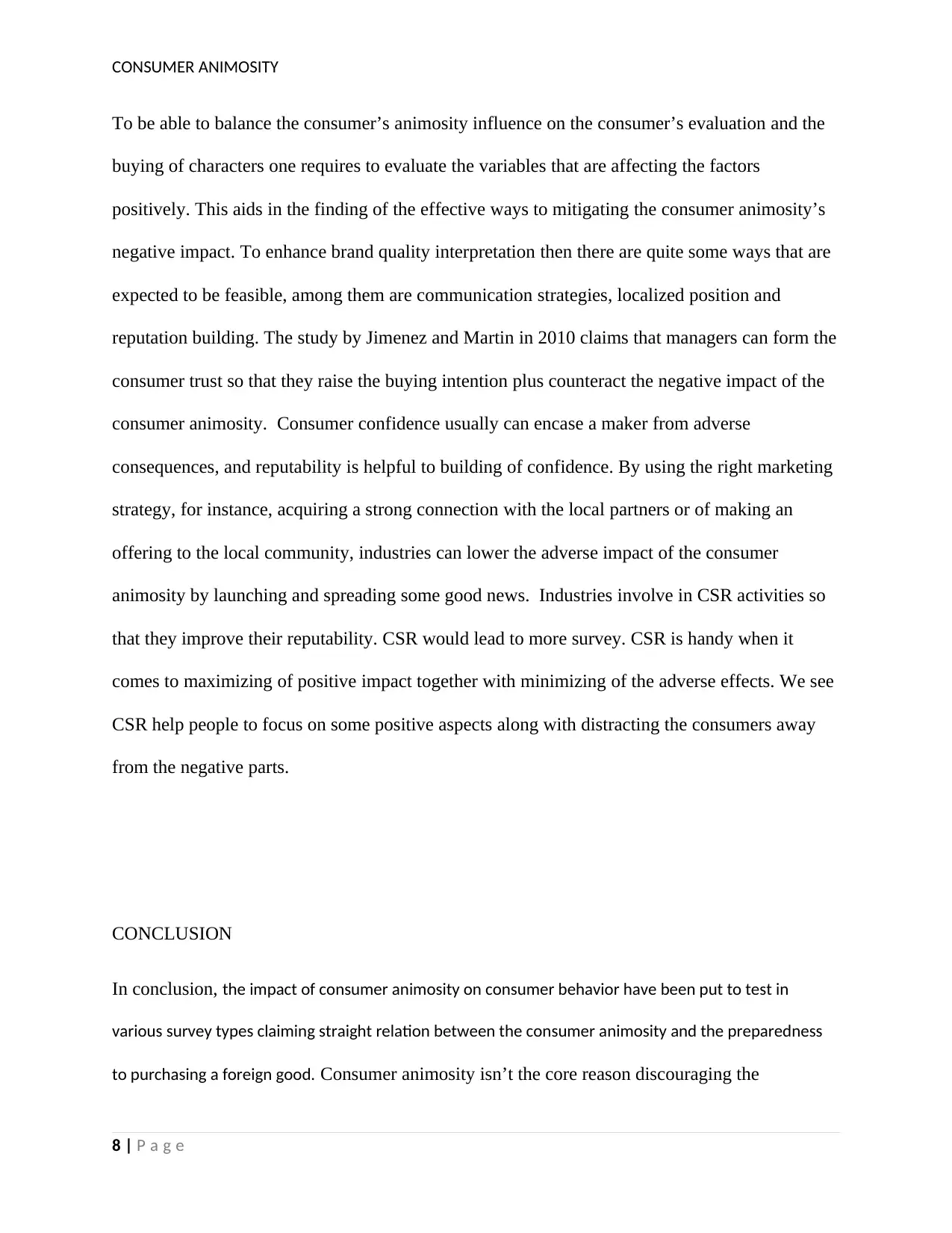
CONSUMER ANIMOSITY
To be able to balance the consumer’s animosity influence on the consumer’s evaluation and the
buying of characters one requires to evaluate the variables that are affecting the factors
positively. This aids in the finding of the effective ways to mitigating the consumer animosity’s
negative impact. To enhance brand quality interpretation then there are quite some ways that are
expected to be feasible, among them are communication strategies, localized position and
reputation building. The study by Jimenez and Martin in 2010 claims that managers can form the
consumer trust so that they raise the buying intention plus counteract the negative impact of the
consumer animosity. Consumer confidence usually can encase a maker from adverse
consequences, and reputability is helpful to building of confidence. By using the right marketing
strategy, for instance, acquiring a strong connection with the local partners or of making an
offering to the local community, industries can lower the adverse impact of the consumer
animosity by launching and spreading some good news. Industries involve in CSR activities so
that they improve their reputability. CSR would lead to more survey. CSR is handy when it
comes to maximizing of positive impact together with minimizing of the adverse effects. We see
CSR help people to focus on some positive aspects along with distracting the consumers away
from the negative parts.
CONCLUSION
In conclusion, the impact of consumer animosity on consumer behavior have been put to test in
various survey types claiming straight relation between the consumer animosity and the preparedness
to purchasing a foreign good. Consumer animosity isn’t the core reason discouraging the
8 | P a g e
To be able to balance the consumer’s animosity influence on the consumer’s evaluation and the
buying of characters one requires to evaluate the variables that are affecting the factors
positively. This aids in the finding of the effective ways to mitigating the consumer animosity’s
negative impact. To enhance brand quality interpretation then there are quite some ways that are
expected to be feasible, among them are communication strategies, localized position and
reputation building. The study by Jimenez and Martin in 2010 claims that managers can form the
consumer trust so that they raise the buying intention plus counteract the negative impact of the
consumer animosity. Consumer confidence usually can encase a maker from adverse
consequences, and reputability is helpful to building of confidence. By using the right marketing
strategy, for instance, acquiring a strong connection with the local partners or of making an
offering to the local community, industries can lower the adverse impact of the consumer
animosity by launching and spreading some good news. Industries involve in CSR activities so
that they improve their reputability. CSR would lead to more survey. CSR is handy when it
comes to maximizing of positive impact together with minimizing of the adverse effects. We see
CSR help people to focus on some positive aspects along with distracting the consumers away
from the negative parts.
CONCLUSION
In conclusion, the impact of consumer animosity on consumer behavior have been put to test in
various survey types claiming straight relation between the consumer animosity and the preparedness
to purchasing a foreign good. Consumer animosity isn’t the core reason discouraging the
8 | P a g e
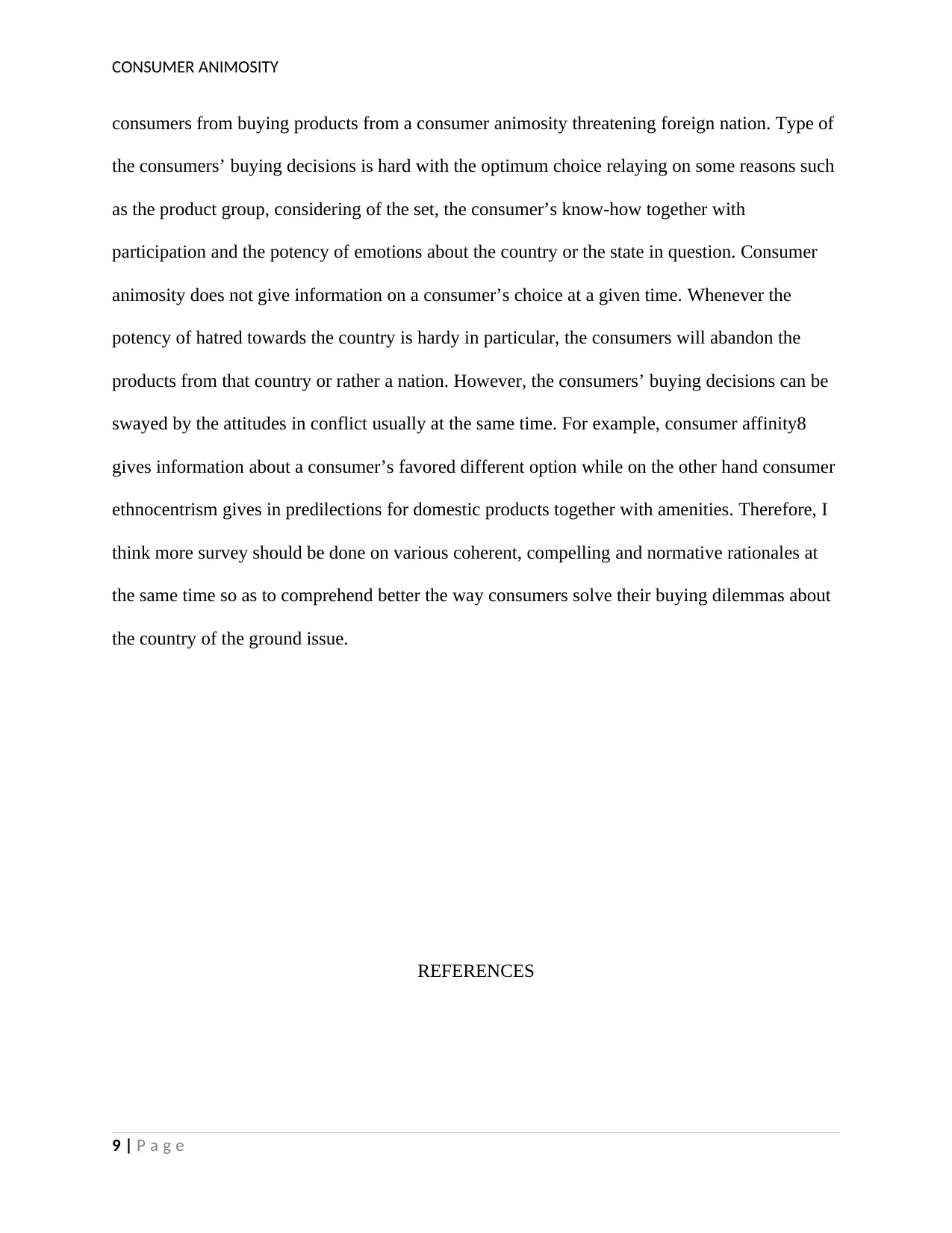
CONSUMER ANIMOSITY
consumers from buying products from a consumer animosity threatening foreign nation. Type of
the consumers’ buying decisions is hard with the optimum choice relaying on some reasons such
as the product group, considering of the set, the consumer’s know-how together with
participation and the potency of emotions about the country or the state in question. Consumer
animosity does not give information on a consumer’s choice at a given time. Whenever the
potency of hatred towards the country is hardy in particular, the consumers will abandon the
products from that country or rather a nation. However, the consumers’ buying decisions can be
swayed by the attitudes in conflict usually at the same time. For example, consumer affinity8
gives information about a consumer’s favored different option while on the other hand consumer
ethnocentrism gives in predilections for domestic products together with amenities. Therefore, I
think more survey should be done on various coherent, compelling and normative rationales at
the same time so as to comprehend better the way consumers solve their buying dilemmas about
the country of the ground issue.
REFERENCES
9 | P a g e
consumers from buying products from a consumer animosity threatening foreign nation. Type of
the consumers’ buying decisions is hard with the optimum choice relaying on some reasons such
as the product group, considering of the set, the consumer’s know-how together with
participation and the potency of emotions about the country or the state in question. Consumer
animosity does not give information on a consumer’s choice at a given time. Whenever the
potency of hatred towards the country is hardy in particular, the consumers will abandon the
products from that country or rather a nation. However, the consumers’ buying decisions can be
swayed by the attitudes in conflict usually at the same time. For example, consumer affinity8
gives information about a consumer’s favored different option while on the other hand consumer
ethnocentrism gives in predilections for domestic products together with amenities. Therefore, I
think more survey should be done on various coherent, compelling and normative rationales at
the same time so as to comprehend better the way consumers solve their buying dilemmas about
the country of the ground issue.
REFERENCES
9 | P a g e
⊘ This is a preview!⊘
Do you want full access?
Subscribe today to unlock all pages.

Trusted by 1+ million students worldwide
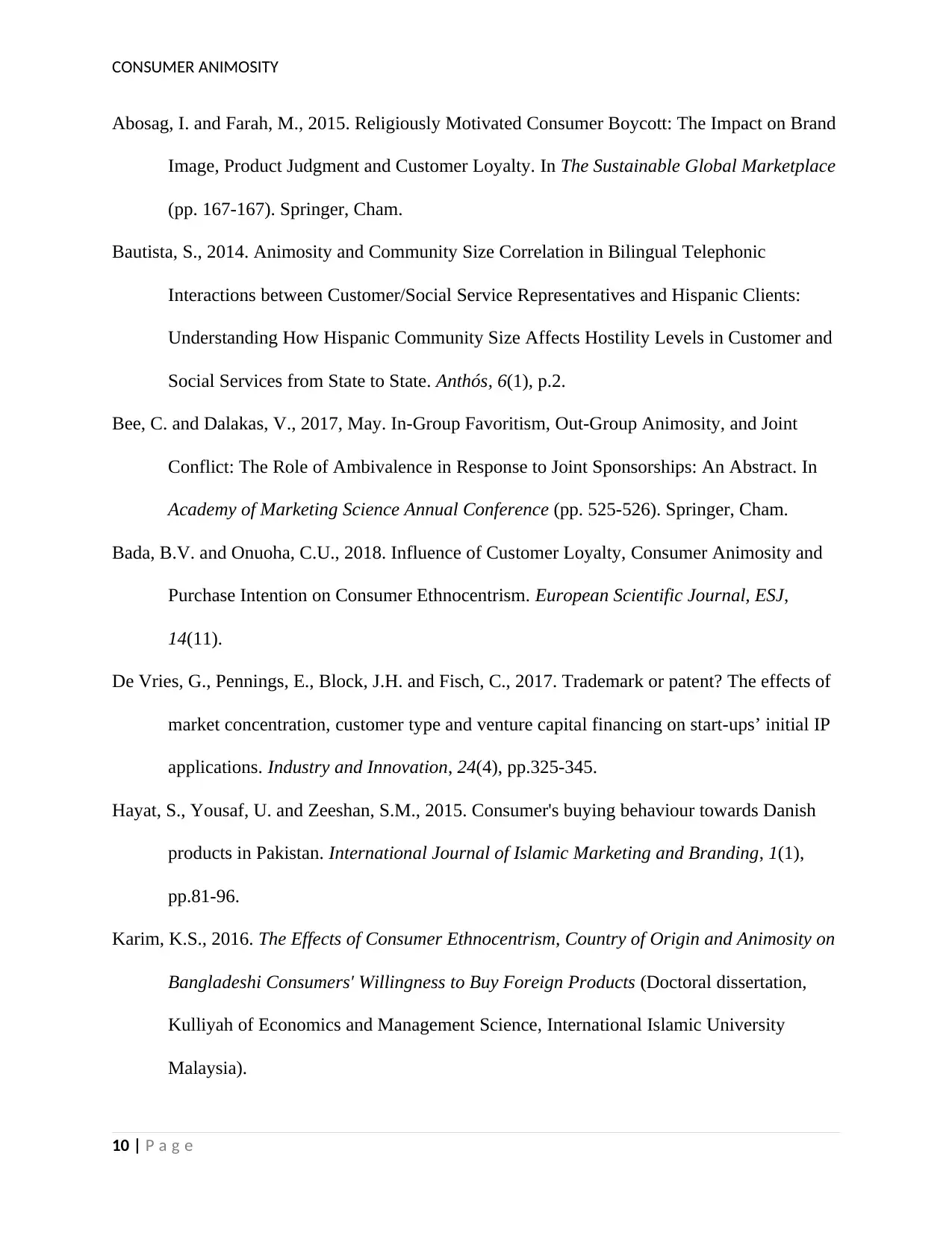
CONSUMER ANIMOSITY
Abosag, I. and Farah, M., 2015. Religiously Motivated Consumer Boycott: The Impact on Brand
Image, Product Judgment and Customer Loyalty. In The Sustainable Global Marketplace
(pp. 167-167). Springer, Cham.
Bautista, S., 2014. Animosity and Community Size Correlation in Bilingual Telephonic
Interactions between Customer/Social Service Representatives and Hispanic Clients:
Understanding How Hispanic Community Size Affects Hostility Levels in Customer and
Social Services from State to State. Anthós, 6(1), p.2.
Bee, C. and Dalakas, V., 2017, May. In-Group Favoritism, Out-Group Animosity, and Joint
Conflict: The Role of Ambivalence in Response to Joint Sponsorships: An Abstract. In
Academy of Marketing Science Annual Conference (pp. 525-526). Springer, Cham.
Bada, B.V. and Onuoha, C.U., 2018. Influence of Customer Loyalty, Consumer Animosity and
Purchase Intention on Consumer Ethnocentrism. European Scientific Journal, ESJ,
14(11).
De Vries, G., Pennings, E., Block, J.H. and Fisch, C., 2017. Trademark or patent? The effects of
market concentration, customer type and venture capital financing on start-ups’ initial IP
applications. Industry and Innovation, 24(4), pp.325-345.
Hayat, S., Yousaf, U. and Zeeshan, S.M., 2015. Consumer's buying behaviour towards Danish
products in Pakistan. International Journal of Islamic Marketing and Branding, 1(1),
pp.81-96.
Karim, K.S., 2016. The Effects of Consumer Ethnocentrism, Country of Origin and Animosity on
Bangladeshi Consumers' Willingness to Buy Foreign Products (Doctoral dissertation,
Kulliyah of Economics and Management Science, International Islamic University
Malaysia).
10 | P a g e
Abosag, I. and Farah, M., 2015. Religiously Motivated Consumer Boycott: The Impact on Brand
Image, Product Judgment and Customer Loyalty. In The Sustainable Global Marketplace
(pp. 167-167). Springer, Cham.
Bautista, S., 2014. Animosity and Community Size Correlation in Bilingual Telephonic
Interactions between Customer/Social Service Representatives and Hispanic Clients:
Understanding How Hispanic Community Size Affects Hostility Levels in Customer and
Social Services from State to State. Anthós, 6(1), p.2.
Bee, C. and Dalakas, V., 2017, May. In-Group Favoritism, Out-Group Animosity, and Joint
Conflict: The Role of Ambivalence in Response to Joint Sponsorships: An Abstract. In
Academy of Marketing Science Annual Conference (pp. 525-526). Springer, Cham.
Bada, B.V. and Onuoha, C.U., 2018. Influence of Customer Loyalty, Consumer Animosity and
Purchase Intention on Consumer Ethnocentrism. European Scientific Journal, ESJ,
14(11).
De Vries, G., Pennings, E., Block, J.H. and Fisch, C., 2017. Trademark or patent? The effects of
market concentration, customer type and venture capital financing on start-ups’ initial IP
applications. Industry and Innovation, 24(4), pp.325-345.
Hayat, S., Yousaf, U. and Zeeshan, S.M., 2015. Consumer's buying behaviour towards Danish
products in Pakistan. International Journal of Islamic Marketing and Branding, 1(1),
pp.81-96.
Karim, K.S., 2016. The Effects of Consumer Ethnocentrism, Country of Origin and Animosity on
Bangladeshi Consumers' Willingness to Buy Foreign Products (Doctoral dissertation,
Kulliyah of Economics and Management Science, International Islamic University
Malaysia).
10 | P a g e
Paraphrase This Document
Need a fresh take? Get an instant paraphrase of this document with our AI Paraphraser
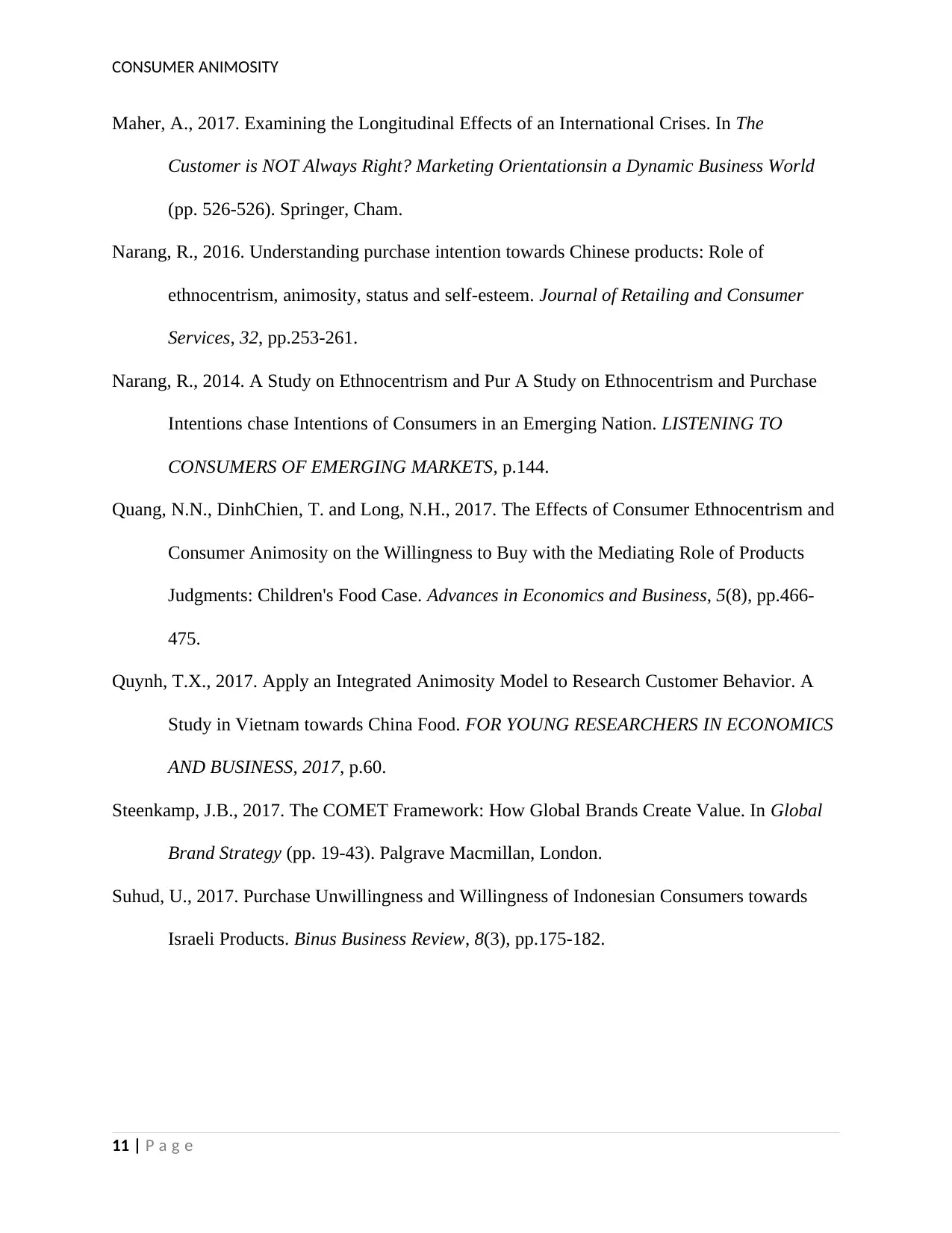
CONSUMER ANIMOSITY
Maher, A., 2017. Examining the Longitudinal Effects of an International Crises. In The
Customer is NOT Always Right? Marketing Orientationsin a Dynamic Business World
(pp. 526-526). Springer, Cham.
Narang, R., 2016. Understanding purchase intention towards Chinese products: Role of
ethnocentrism, animosity, status and self-esteem. Journal of Retailing and Consumer
Services, 32, pp.253-261.
Narang, R., 2014. A Study on Ethnocentrism and Pur A Study on Ethnocentrism and Purchase
Intentions chase Intentions of Consumers in an Emerging Nation. LISTENING TO
CONSUMERS OF EMERGING MARKETS, p.144.
Quang, N.N., DinhChien, T. and Long, N.H., 2017. The Effects of Consumer Ethnocentrism and
Consumer Animosity on the Willingness to Buy with the Mediating Role of Products
Judgments: Children's Food Case. Advances in Economics and Business, 5(8), pp.466-
475.
Quynh, T.X., 2017. Apply an Integrated Animosity Model to Research Customer Behavior. A
Study in Vietnam towards China Food. FOR YOUNG RESEARCHERS IN ECONOMICS
AND BUSINESS, 2017, p.60.
Steenkamp, J.B., 2017. The COMET Framework: How Global Brands Create Value. In Global
Brand Strategy (pp. 19-43). Palgrave Macmillan, London.
Suhud, U., 2017. Purchase Unwillingness and Willingness of Indonesian Consumers towards
Israeli Products. Binus Business Review, 8(3), pp.175-182.
11 | P a g e
Maher, A., 2017. Examining the Longitudinal Effects of an International Crises. In The
Customer is NOT Always Right? Marketing Orientationsin a Dynamic Business World
(pp. 526-526). Springer, Cham.
Narang, R., 2016. Understanding purchase intention towards Chinese products: Role of
ethnocentrism, animosity, status and self-esteem. Journal of Retailing and Consumer
Services, 32, pp.253-261.
Narang, R., 2014. A Study on Ethnocentrism and Pur A Study on Ethnocentrism and Purchase
Intentions chase Intentions of Consumers in an Emerging Nation. LISTENING TO
CONSUMERS OF EMERGING MARKETS, p.144.
Quang, N.N., DinhChien, T. and Long, N.H., 2017. The Effects of Consumer Ethnocentrism and
Consumer Animosity on the Willingness to Buy with the Mediating Role of Products
Judgments: Children's Food Case. Advances in Economics and Business, 5(8), pp.466-
475.
Quynh, T.X., 2017. Apply an Integrated Animosity Model to Research Customer Behavior. A
Study in Vietnam towards China Food. FOR YOUNG RESEARCHERS IN ECONOMICS
AND BUSINESS, 2017, p.60.
Steenkamp, J.B., 2017. The COMET Framework: How Global Brands Create Value. In Global
Brand Strategy (pp. 19-43). Palgrave Macmillan, London.
Suhud, U., 2017. Purchase Unwillingness and Willingness of Indonesian Consumers towards
Israeli Products. Binus Business Review, 8(3), pp.175-182.
11 | P a g e
1 out of 11
Your All-in-One AI-Powered Toolkit for Academic Success.
+13062052269
info@desklib.com
Available 24*7 on WhatsApp / Email
![[object Object]](/_next/static/media/star-bottom.7253800d.svg)
Unlock your academic potential
Copyright © 2020–2025 A2Z Services. All Rights Reserved. Developed and managed by ZUCOL.